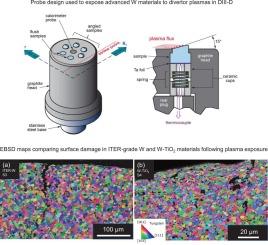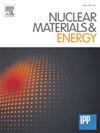Recrystallization, cracking, and erosion of dispersoid-strengthened tungsten materials during exposure to divertor plasmas
IF 2.7
2区 物理与天体物理
Q1 NUCLEAR SCIENCE & TECHNOLOGY
引用次数: 0
Abstract
In this study, we investigated the effects of combined intense particle and heat flux exposure on advanced tungsten plasma-facing materials within the DIII-D fusion facility. Our test matrix included two types of dispersoid-strengthened tungsten (containing either 100 nm diameter TiO2 or Ni particles), along with high-purity polycrystalline tungsten as a reference. This experiment relied on a sample geometry angled at 15° relative to the divertor surface, thereby allowing the surfaces to intercept steady-state perpendicular heat fluxes () ranging from 10.1 to 19.6 MW/m2. During each shot, the samples were exposed to 42 Hz edge-localized modes (ELMs), allowing us to test the material response to transient heating. We correlated the exposure conditions with extensive post-test surface composition analysis and microscopy to determine how the plasma modified each surface. The angled specimens closest to the strike point received the highest combined heat and particle flux and melted midway through the experiment. EBSD analysis revealed they were completely recrystallized throughout, with an average grain size >100 µm. On the other hand, the specimens that received a lower steady state heat flux survived with more superficial surface damage. Whereas the high-purity polycrystalline tungsten exhibited a higher surface roughness, the dispersoid-strengthened material exhibited more extensive shallow inter-granular cracking. In addition, the surface was depleted of dispersoids following plasma exposure, possibly because of evaporation and/or sputtering. The results described here provide insights into the performance of these materials in a fusion environment which can guide further optimization for use in long-pulse devices.

分散增强钨材料暴露于分流等离子体时的再结晶、开裂和侵蚀
在这项研究中,我们研究了在DIII-D聚变设施中,强粒子和热通量联合暴露对先进钨等离子体表面材料的影响。我们的测试基质包括两种分散体增强钨(含有100nm直径的TiO2或Ni颗粒),以及作为参考的高纯度多晶钨。该实验依赖于相对于分流器表面的15°角度的样本几何形状,从而允许表面拦截稳态垂直热通量(q⊥),范围从10.1到19.6 MW/m2。在每次拍摄过程中,样品暴露在42 Hz的边缘局部化模式(elm)下,使我们能够测试材料对瞬态加热的响应。我们将暴露条件与广泛的测试后表面成分分析和显微镜相关联,以确定等离子体如何修饰每个表面。最接近撞击点的倾斜试样获得最高的热和粒子通量,并在实验过程中熔化。EBSD分析显示,它们完全再结晶,平均晶粒尺寸为100µm。另一方面,接受较低稳态热通量的试样存活,表面损伤较多。高纯度多晶钨的表面粗糙度较高,而分散体增强材料则表现出更广泛的浅晶间裂纹。此外,等离子体暴露后,表面的分散体被耗尽,可能是由于蒸发和/或溅射。本文描述的结果为这些材料在聚变环境中的性能提供了见解,可以指导在长脉冲器件中使用的进一步优化。
本文章由计算机程序翻译,如有差异,请以英文原文为准。
求助全文
约1分钟内获得全文
求助全文
来源期刊

Nuclear Materials and Energy
Materials Science-Materials Science (miscellaneous)
CiteScore
3.70
自引率
15.40%
发文量
175
审稿时长
20 weeks
期刊介绍:
The open-access journal Nuclear Materials and Energy is devoted to the growing field of research for material application in the production of nuclear energy. Nuclear Materials and Energy publishes original research articles of up to 6 pages in length.
 求助内容:
求助内容: 应助结果提醒方式:
应助结果提醒方式:


